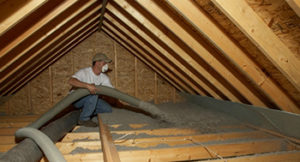Cellulose Insulation Can Improve Green Design

Designing green buildings just got easier with the help of cellulose insulation. Made from paper waste, cellulose insulation consists of approximately 85 percent recycled content. Using this green building material can reduce the amount of energy required to heat a building while lowering the carbon footprint of any expansion, renovation or construction project.
Cellulose insulation is treated with a natural, non-toxic borate product that also qualifies as a Class I fire-retardant, according to Green Building Elements, These treatments make it nearly impossible for bugs and rodents to thrive in cellulose-insulated spaces. Cellulose is also mold resistant, making it an ideal form of insulation for commercial buildings like hospitals, schools and offices.
Cellulose is easy to obtain as the U.S. Forest Industry has maintained a sustainable supply of planted trees designated for both building and paper products. In addition, recycling programs across the U.S. provide ample recycled materials for cellulose insulation production.
Cotton, straw, hemp, corncob, sawdust, cardboard and newspaper are all examples cellulosic materials that can be used for insulation, according to a statement from Green Building Elements.
During the installation process, cellulose presents little waste or leftover material that needs to be thrown out. All unused material can be swept up, returned to the supplier or facility and used in the next installation project.
For expansion and renovation projects, cellulose insulation is available in a wide variety of formats, including loose-fill and blanket forms. Loose-fill can be applied as a moisture-added spray into open wall framing, dry dense-packed into enclosed framing cavities and dry blown into open attics.
Cellulose has excellent insulating properties that are stronger than fiberglass according to a statement. Cellulose is especially effective at tightly filling walls, increasing energy efficiency by reducing air pockets. It’s ideal for compact areas filled with pipes and wiring since the material can fill any space.
A study performed by the University of Colorado School of Architecture and Planning compared two seemingly identical structures. One was insulated with cellulose and the other with fiberglass. The cellulose insulation performed much better, losing 26.4 percent less heat energy compared to the fiberglass. The cellulose insulation also made the structure 30 percent more airtight.
“Building A (cellulose) maintained an average temperature of 72.32 degrees Fahrenheit while Building B (fiberglass) maintained an average temperature of 71.98 degrees Fahrenheit,” according to the study.
According to the Electronic Components Industry Association (ECIA), one of the earliest forms of cellulose material used as insulation in the U.S. was balsa wool or sawdust from balsa wood wrapped in paper packages.
While any type of insulation can improve a building’s energy efficiency, using cellulose insulation can contribute to obtaining LEED certification credits from the USGBC.
By Jacqueline Tortorello
